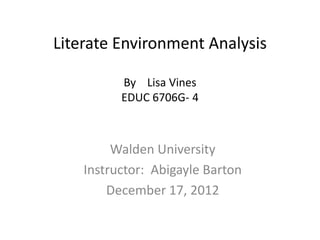
Literate environment
- 1. Literate Environment Analysis By Lisa Vines EDUC 6706G- 4 Walden University Instructor: Abigayle Barton December 17, 2012
- 2. Getting to Know Literacy Learners • “Commercial reading inventories typically contain graded word lists, reading passages, and a series of comprehension questions and requests to retell that are used to gauge students’ understanding of text” (Afflerbach, 2012, p.29). • Struggling readers need explicit instruction that will help make reading skills and strategies clear to them. Teachers need to provide clear, precise and intensive instructions to change struggling readers to successful readers. (Laureate Education, 2010b). • Young children begin reading by recognizing logos on fast-food restaurants, department stores, grocery stores, and commonly used household items within familiar contexts (Tompkins, 2010, p. 114).
- 3. Selecting Texts Teachers often use various genres when reading to students. They frequently ask questions and review various first grade reading skills. Teachers allow students to select different books that they may find interesting. In early years we do not give enough information text. When they get older they get a lot of informational text and they struggle (Laureate Education, Inc., 2011d). Districts also utilizes basal readers as part of their reading curriculum. “Commercial reading programs, commonly called basal readers, have been a staple ns reading instruction for 150 years” (Tompkins, 2010, p. 325). Teachers are forced to use the materials in the basal readers and to only use supplemental materials with permission. Principal do not want teachers to use other reading sources. At times it is very difficult to teach some of the reading standards without the use of other resources. All students do not learn the same way. It is important to use many resources to meet the needs of all students learning styles. “Publishers of basal reading textbooks tout their programs as complete literacy programs containing all the materials needed for students to become successful readers” (Tompkins, 2010, p. 325). It is important to consider when selecting text how linguistic or semiotic the choice is (Laureate Education, Inc., 2011d).
- 4. Selecting Appropriate Text • Text should cover • When selecting appropriate informational or nonfiction text for students you should text, stories, narratives or consider readability, text poetry (Tompkins, 2010) length, text structure, size of print and visual support.
- 5. Literacy Lesson: Interactive Perspective “Students’ knowledge is organized into cognitive structures called schemas, and schema theory describes the processes students use to learn” (Tompkins, 2010, p. 7). The visual aid she used in the video to show how the brain stores information was very helpful (Laureate Education, 2011). My students grasped the concept and were able to show their understanding by the folder activities they produced. They were able to make a connection between the text-self as were the students in the video presentation. “Teachers often direct students toward the big ideas when they encourage them to make predictions” (Tompkins, 2010, p. 263).
- 6. “Students learn to use a variety of cognitive and metacognitive strategies to ensure that they comprehend what they’re reading” (Tompkins, 2010, p. 261).
- 7. Responsive and Critical Perspectives Responsive Perspective Critical Perspective * discuss * examine *interpret *evaluate * connect *judge • Students are able to • Students are provided the respond to text. They have opportunity to think the opportunity to discuss analytically about a text. their prior knowledge and They are able to make compare to text. connections to the text.
- 8. Critical Response Interactive Perspective Perspective Perspective Good Reader All three perspectives are necessary to produce a good reader who can read and think critically (Laureate Education, 2010).
- 9. Resources Afflerbach,P. (2012). Understanding and using reading assessment, k-12 (2nd ed.). Newark, DE: International Reading Association. Laureate Education, Inc. (Executive Producer). (2011a). Literacy Autobiographies. [Webcast]. Baltimore, MD: Author. Laureate Education, Inc. (Executive Producer). (2011b). Getting to Know Your Students. {Webcast}. Baltimore, MD: Author. Laureate Education, Inc. (Executive Producer). (2011c). Reading Inventories. {Webcast}. Baltimore, MD: Author. Laureate Education, Inc. (Executive Producer). (2011d). Analyzing and Selecting Text. [Webcast]. Action Research for Educators. Baltimore, MD: Author Tompkins, G.E. (2010). Literacy for the 21st century: A balanced approach (5th ed.). Boston: Allyn & Bacon.